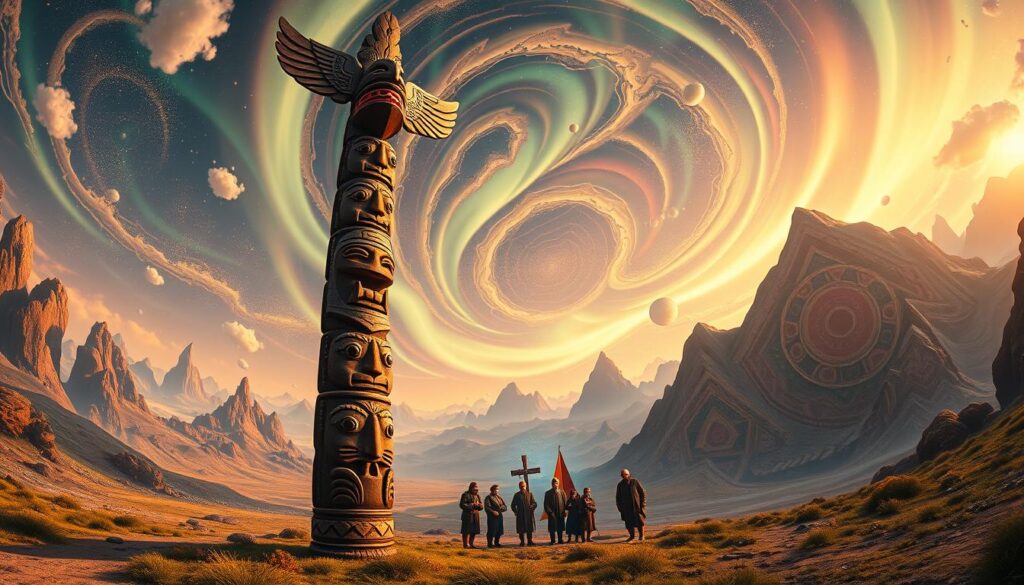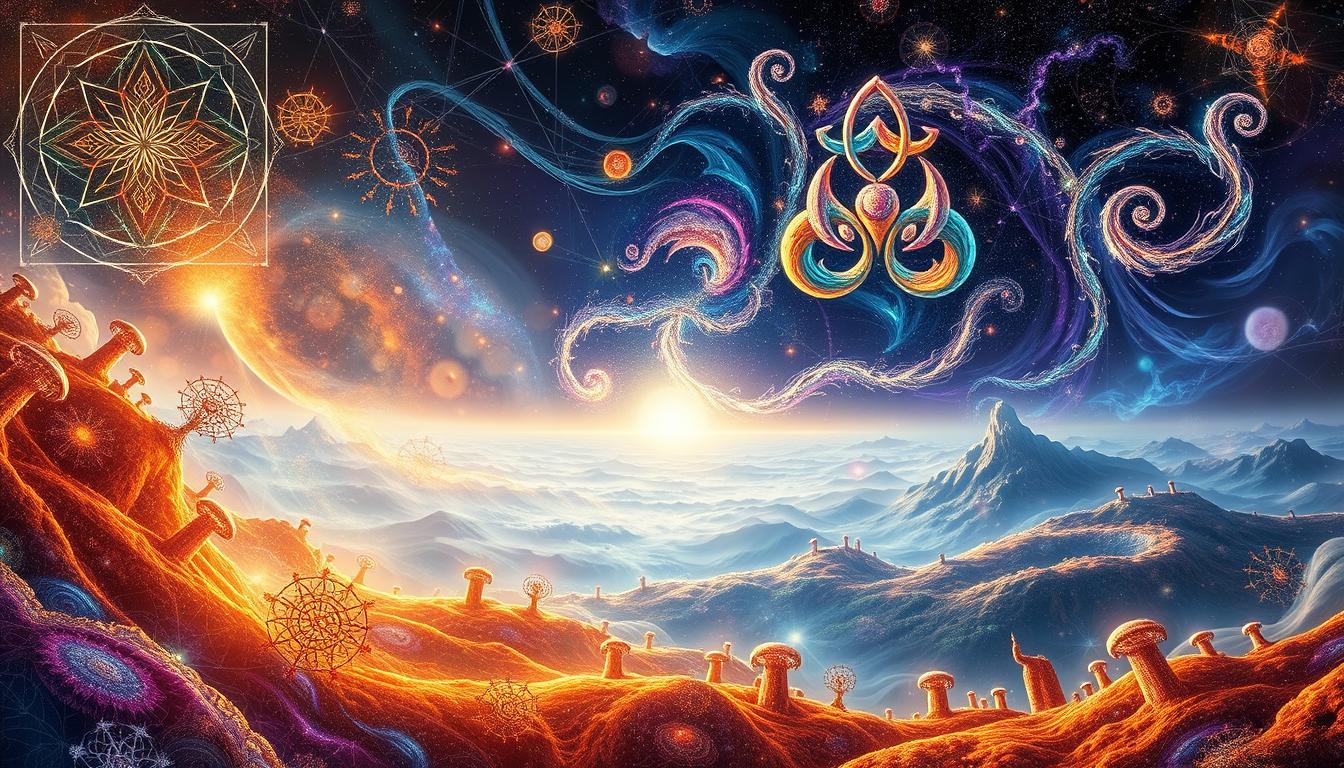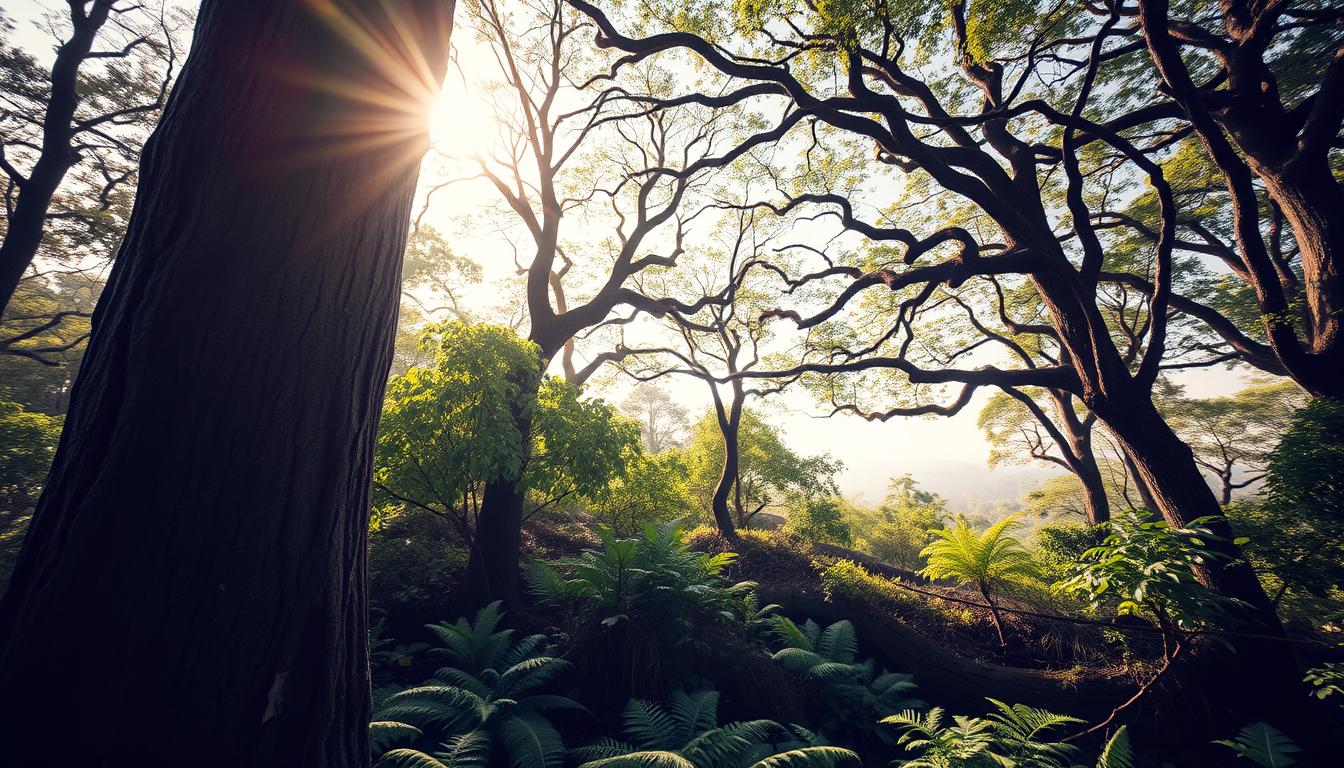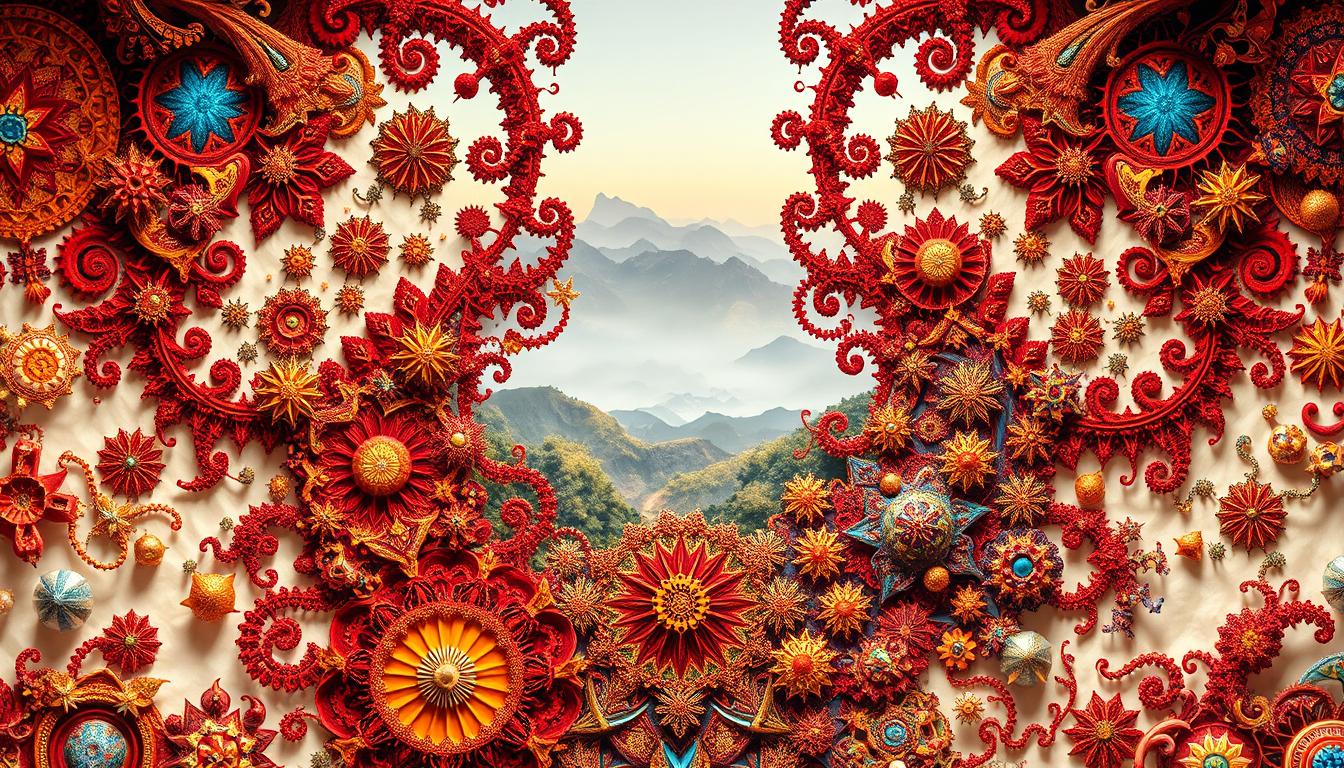In exploring our existence’s deeper facets, it’s vital to consider indigenous viewpoints. These highlight reality’s fractal nature. Indigenous wisdom offers insights into how life and nature intertwine, reflecting a deep spirituality.
Across diverse Indigenous cultures, life’s complexity is often seen through fractal patterns. These self-similar shapes resonate across different scales. This perspective shows the richness of ecological relationships and life’s subtle details. It stresses the value of Indigenous knowledge, challenging Western views.
Introduction to Indigenous Perspectives
Indigenous views provide a deep cultural insight, different from common thoughts. These perspectives mix personal identity with community and nature ties. They stress on everything being connected. Learning is a life-long path filled with personal and shared moments.
These ideas are built on the thought that there’s more to truth than just facts. Indigenous people value spiritual and relationship elements. This approach leads to a fuller cultural insight. It shows the complex ways of life. Knowledge grows from history, culture, and surroundings.

Exploring Indigenous ways of thinking highlights the importance of identity in understanding life. It opens wider conversations about our role in the world. It welcomes different viewpoints to discuss life’s intricate patterns.
Understanding Fractals in Nature
Fractals create complex patterns that we see all around us in nature. They are made from repeating simple processes and show a principle called self-similarity. This means we see similar patterns in things like coastlines, mountains, and branches but at different sizes.
Fractals help us understand how ecosystems work. They show that every part of an ecosystem adds to a bigger picture. This idea is like Indigenous views that emphasize balance and harmony in nature.
Learning about fractals, we see how every aspect of nature is linked. They remind us how everything in nature works together. This understanding helps us see the world as a connected whole, where each part is important.
The Concept of Reality in Indigenous Cultures
Indigenous cultures have their unique way of understanding reality. It’s shaped by deep spiritual beliefs. Unlike the West’s clear-cut views, these cultures see everything as connected. This perspective shows how people, nature, and the cosmos all work together. This creates a complete experience of what being alive means.
For Indigenous communities, reality constantly changes. It combines both the physical world and spiritual realms. They believe in the sacredness of nature and their bond with it. This creates a strong sense of duty to care for the environment.
These cultures believe everything in life is connected. Humans, animals, plants, and even rocks are part of this connection. So, spirituality is a key part of their everyday lives. It shapes how they see and interact with the world around them.
Indigenous views challenge Western ways of thinking. They don’t believe in separating and competing. Instead, they see reality as everything being part of a whole. This promotes a world where all life is respected and linked. Their spiritual teachings offer valuable lessons on reality and our role in it.
Indigenous Perspectives on the Fractal Nature of Reality
North American Indigenous cultures have a deep understanding of the fractal nature of reality. Their beliefs show how everything in existence is connected. This view helps us see the world through their eyes, deepening our appreciation of their relationship with the universe.
Examples from North American Indigenous Cultures
In Native American traditions, the seasons teach us about life’s cycles. For example:
- The movements of animals highlight the cycle of life and death, showing us the power of renewal.
- Community designs reflect the world, showing how people, nature, and the cosmos are linked.
- Tribes honor migrations, seeing them as key to their culture and survival, and a sign of their deep connection to the environment.
Cross-Cultural Comparisons with Other Indigenous Nations
When we look at Indigenous cultures across the world, we find similar beliefs. For example, the Himalayan and Maori people also see the world through a fractal lens. These cultures teach us:
- Existence is non-linear, blending past, present, and future.
- Rituals and myths highlight our bond with nature, echoing local ecosystems.
- Shared stories and beliefs strengthen community ties and spiritual insight.
Connection Between Indigenous Knowledge and Science
The relationship between Indigenous knowledge systems and Western science is deeply intertwined. It offers valuable insights and challenges. When we merge Indigenous perspectives with science education, we make learning richer. We also make education more just for everyone. This approach boosts scientific inquiry and respects different ways of knowing that were once ignored in schools.
Building Bridges Between Different Knowledge Systems
There are many ways to connect Indigenous knowledge with science education. Each way values Indigenous methods. For example, this could mean:
- Using traditional ecological knowledge in environmental science classes.
- Using teaching materials that show Indigenous viewpoints.
- Starting research projects that blend Western and Indigenous ways.
Such efforts highlight how Indigenous knowledge can shape science. They make our learning spaces more welcoming for everyone.
Postcolonial Perspectives on Indigenous Knowledge
Postcolonial critiques are key in pushing for the decolonization of knowledge. They show why it’s important to value Indigenous wisdom. Important points are:
- Showing how Indigenous communities have been wronged in education and science.
- Calling for a rethink of what we see as valid knowledge in schools.
- Encouraging talks that respect both Indigenous and Western science methods.
This push for decolonization not only questions old views but also helps us appreciate knowledge as something that varies with culture.
Holistic Approaches to Reality Among Indigenous Peoples
Indigenous people see reality in a broad way, linking physical, spiritual, and emotional health with community well-being. This viewpoint ties individuals to their environment and society. It shows how each part of life is part of something bigger, linked to nature’s complex web.
Community holds a key place in this broad understanding. Indigenous methods highlight group involvement, building relationships that help everyone’s well-being. This way of working together brings shared knowledge and enriches our grasp of reality.
Indigenous respect for nature teaches us to deeply value all living connections. Nature is more than just a resource; it’s a vital ally in staying well. This bond with nature encourages sustainable living and taking care of our environment.
Mathematics and Nature: Indigenous Quantitative Methods
Indigenous cultures have a deep math understanding through unique methods. They mix spirituality with numbers, showing math’s wider role. These methods are about more than counting; they connect stories, community, and the environment’s unity.
The Integration of Spiritual and Rational Understanding
Indigenous research combines spiritual and logical thinking. This mix gives data a richer meaning. By looking at the big picture, these methods find value in nature and community bonds.
Case Studies: Indigenous Research Methodologies
Many case studies prove Indigenous methods work well. They show how these approaches meet community needs and honor spiritual ties. For instance, some groups use ecology and math to guide land care, blending science with spiritual respect. This shows Indigenous math can help communities thrive.
Impacts of Colonialism on Indigenous Worldviews
Colonialism changed Indigenous peoples’ ways of seeing the world. It brought foreign ideas that clashed with their own. Their deep ties to nature and the universe were ignored. This led to the loss of languages and traditions.
Indigenous groups faced tough times because of colonialism. They went through historical trauma. This hurt their ability to keep their culture alive. It harmed their bond with the land and each other.
To heal, focusing on bringing back their cultures is key. This helps them be resilient. It lets them honor their ancestors’ wisdom. By doing this, they can tell their own stories again.
Modern Applications of Indigenous Fractal Understanding
Indigenous knowledge gives us great insight into today’s issues, especially in conservation and education. It teaches us that all life is connected. This wisdom leads us to protect our environment and helps shape today’s conservation work.
Influence on Environmental Conservation Efforts
For ages, Indigenous peoples have used their local ecosystem knowledge to conserve the environment. Their practices show a rich understanding of biodiversity and species interaction. Including their wisdom in modern conservation can lead to more complete strategies. These strategies include:
- Community involvement in land management activities
- Recognition of traditional ecological knowledge
- Promotion of sustainability through cultural practices
By highlighting these points, we mix modern science with ancient Indigenous methods. This creates a fuller conversation about caring for our planet.
Education and Reconciliation through Indigenous Knowledge
Schools are now using Indigenous perspectives to teach history and conservation. This helps with reconciliation. Here’s how they’re doing it:
- Developing programs that integrate Indigenous knowledge and practices
- Creating partnerships between schools and Indigenous communities
- Encouraging cross-cultural dialogue to foster mutual respect
Through these steps, education is not just about reconciliation. It also teaches students to value Indigenous insights. This supports a fairer and more sustainable future.
Conclusion
Exploring Indigenous views shows us a world where everything is connected. This journey helps us see how all aspects of life fit together. Indigenous wisdom teaches us to look beyond simple explanations, showing that everything is part of a bigger whole.
When we welcome Indigenous insights, we learn new ways to live and solve problems. These teachings urge us to care for our world and each other more thoughtfully. By applying this ancient wisdom, we can face today’s global issues with better strategies.
Valuing Indigenous knowledge enriches our understanding of the world. It pushes us to see things differently, paving the way for real change. This appreciation is crucial for creating a balanced existence with nature and society.



